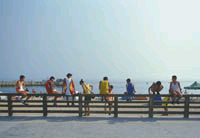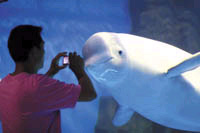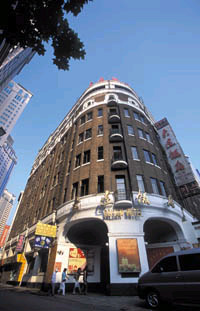It's chilly, and a mist is falling at 10am as Wang Li sits on the edge of a wooden boat that has been winched far up onto the shore. Tangled nets lie to the side on the pebbles, and the morning catch is already at the market just a hundred or so yards up the beach. Just offshore boats sit motionless on the flat water, barely discernable in the mist, the soft putt-putt sound of a motor quietly beating in time to the voices of the fishmongers haggling prices with customers.
Wang, 34, has fished in these waters since childhood, joining his uncle on the boats as a teenager. The waters that break against the weathered rocks of this coastline are abundant in shellfish, octopus, sea urchins, crustaceans and other marine life. At around noon the mists have cleared to reveal a pale blue sky, and the market is getting busier as people from town come to stock up on fresh, and remarkably cheap, seafood.
Worlds away from the seashore, in the forested hills inland, a group of young male tigers lie sprawled beneath a wooden viewing platform, lazily eyeing the group of onlookers above. “Ten yuan for three pieces of chicken. Fifty yuan for a whole, live one,” says the keeper to a group of new arrivals. “You could all pitch in just five yuan,” he adds hopefully, but the girls turn away shyly and the boys feign interest in the wildlife. The Forest and Animal Park covers roughly seven square kilometers and sits snug in the green hills that sweep down to the coast, the entire area laced with walking trails that take in the various animals – the big cats, polar bears, wolves, elephants, llamas, marsupials, and emus.
In the south of the peninsula, Laohutan Polar Aquarium has attracted a larger crowd, and visitors mill about at the entrance, clambering over the giant model dinosaurs that inhabit the park, and posing with performers in the square beyond. The aquarium is on Binhai Road, a winding coastal road that stretches for 35 kilometers along the southern edge of the peninsula. Starting in the downtown area, it’s possible to walk the entire route within a day, a perfectly feasible enterprise for the energetic traveler, as even in the peak of the summer the temperatures in this region are relatively mild.
The city of Dalian is surrounded by greenery – forest parks, scenic zones, pebble beaches, and a rugged coastline, but Dalian itself is also a place of hidden calm. It is a city of squares, of quiet hidden corners, of parks, and wide thoroughfares. So even after returning from the surrounding environs, it is possible to retain a sense of the enchantment, the therapeutic joy that comes from splashing in rocky tide pools hunting for crabs, or scrambling down a trail littered with fallen leaves. The scent of salt, of the earth, of the plants and flowers, is a heady antidote to months spent in the city.
The taste of the ocean can also be rediscovered in the numerous seafood restaurants found in the city. The Tian Tian seafood chain has the best reputation, as well as some of the highest prices. The best eateries, however, are in the commercial center of the city, centered around Zhongshan Square, with a range of options and small cafes making it a pleasant place to stroll and relax.
As at sunrise, in the late afternoon Zhongshan Square fills with the city’s residents – badminton players, musicians, tai chi practitioners, students perusing their notes, and old couples who have settled themselves on a bench to watch all this. The buildings around the square date from the Japanese occupation, and now house prestigious corporations including banks and hotels, while close by are the People’s Cultural Club and Peking Opera House, which today serve as the main concert hall and Peking Opera venues.
Several blocks away, the stall owners of the Russian Street are slowly packing up their wares. Many of the stalls sell Russian-themed items, but there are a number of outdoor markets nearby which offer Chinese products – antiques, vases, jade sculptures, and shadow boxes with shell mosaics. At the top of the street, where it opens into a wide square, children play in the disused fountain, now a makeshift racetrack for their battery-powered cars. The buildings are in disrepair, giving this part of the city the feel of an abandoned 1920s movie set. The area around Russian Street in Xigang District probably offers the best concentration of old buildings in Dalian, and while many old buildings throughout the city were destroyed during periodic bouts of renovation, pockets remain, offering an eclectic mix of architectural styles for anyone with a taste for history. Development stemmed from colonial occupation, giving the city a diverse character, much like Hong Kong, Qingdao and Shanghai – but for many, what sets Dalian apart is the cleanliness of the place, with industry located far outside the city center.
Just as in the rest of China, the city is currently experiencing a surge in growth. But having the option of engaging effortlessly with nature is a refreshing alternative that offers a time out from the relentless crush of noise and traffic. The city was originally a minor fishing port, but this changed under Russian influence, and it transformed itself into the second largest commercial port in China.
Yet, unlike many industrialized ports, Dalian developed a strong tourism base and this metropolitan hub has the distinct mindset of an island resort. Provincial government dictates reflect a commitment to the environment and the region boasts excellent air quality. Dalian remains a big tourist draw, but despite the hordes who come to take advantage of the charm and the refreshing environment, you can still find seclusion, peace and tranquility, while enjoying one of China’s most beautiful cities.
(That's Beijing by Richard Restell September 28, 2007)




